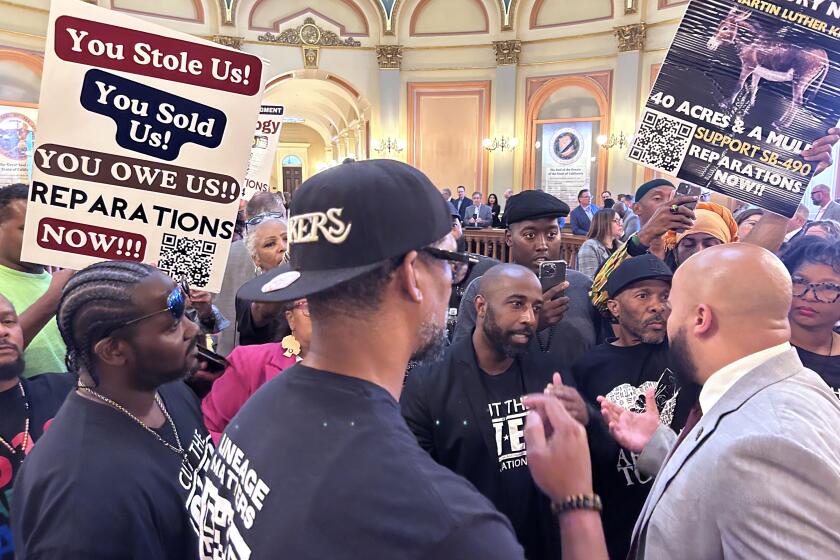Growth Curb Catches Park in the Middle : Oceanside Proposal for Disabled Delayed
- Share via
Monica MacGowan has seen it firsthand, the taunts and pranks sometimes inflicted on the disabled. The mother of three children who have visual impairments, MacGowan has witnessed that sad brand of cruelty children seem to master at an early age.
At first, MacGowan would get
mad. But then, the Oceanside resident came to realize that anger was not a cure for the ignorance of youth. Empathy, she concluded, was the key. For a child to understand and accept the disabled, they need to know the disabled--to roll in the wheelchair, to take the white cane and stroll through darkness.
So it was that MacGowan began a push for Ivey Ranch Park back in 1980. As she saw it, the 18 acres in Oceanside would be a meeting ground for the able-bodied and disabled, a nexus for children of all types to better understand one another. After years of planning and fund raising, construction at the site was set to begin this summer.
Casualty of Law
But now, MacGowan’s dreams for the park have been put on hold, the sorry and seemingly improbable casualty of a new slow-growth ordinance approved by Oceanside voters in April.
It is a Byzantine sort of tale.
To put the brakes on growth, the law established a strict cap on the number of dwellings built in the city each year. That web snared numerous housing developments, among them Ivey Ranch, a 750-acre community of 3,500 homes and a large industrial park planned for the grassy, rolling hills south of Mission Avenue in the San Luis Rey Valley.
Aside from promising to build numerous roads and other public facilities, developers of the massive residential and industrial project planned to donate a key 8.4-acre parcel for Ivey Ranch Park. Now, however, the builders say the new slow-growth law has put their project in limbo,
meaning they will have to delay giving up land for the handicapped park.
City planners estimate it will be at least two years before the developers will, under the new law, be able to build enough homes to satisfy their lenders and get permission to turn over the parcel for Ivey Ranch Park.
In the meantime, MacGowan and other members of the nonprofit group planning the park face the prospect of trying to go forward with work on a site that is missing its virtual centerpiece. Though the organization had already acquired about 10 acres in the area, that land is spread in an awkward half-ring around the parcel scheduled to be donated by the developers, creating problems for any large-scale construction projects.
“It’s frustrating,” said MacGowan, an energetic, dark-haired woman. “It’s been so many years. We would have liked to have seen work going a long time ago. We were grateful to God when it seemed we finally would be going forward, but then this monkey wrench was thrown in.”
Length of Delay a Worry
Backers of the park worry most about the prospect that the delay prompted by Proposition A could stretch even longer.
“How temporary is this going to be?” questioned Joe Aldrich, chairman of the group’s steering board. “That’s the question. How temporary?”
The setback for the park has given opponents of Proposition A fodder for renewed attacks on the new statute. Though proponents of the slow-growth measure say their aim was simply to slow growth, foes contend the dilemma for MacGowan and the rest is a legacy that should have been foreseen.
“Ivey Ranch Park is another victim of an ill-thought out proposition,” said Mayor Larry Bagley, a staunch opponent of the measure. “With Proposition A in place, we’re not going to realize the potential of that park.”
Despite the setback, MacGowan and Aldrich remain optimistic that the park can eventually be finished by the long-standing target date of 1996.
“This park has got to happen,” MacGowan said. “We need to get to our children when they’re young, to educate them to accept people with disabilities.”
When completed, Ivey Ranch Park will be outfitted to suit the needs of both the handicapped and able-bodied.
Well-Equipped Park
Plans call for a campground that will accommodate up to 150 people in cottages fully accessible to the handicapped, picnic sites, a 10,000-square-foot multipurpose gymnasium and theater, a day-care facility for 100 children and an Olympic-size pool.
Among the more unusual features in the works are a sensory trail, which will be lined with pungent herbs and aromatic flowers easily detectable to the blind. Ramps will be installed for wheelchair-bound children and Braille markers will be placed along the trial so that blind visitors can read about the flowers they are smelling.
A petting zoo also is planned, which will include goats, ponies, rabbits and other tame animals that children can touch. A bird aviary has already been erected on the park land and is filled with doves, which the youths can listen to or hold.
Organizers also are toying with the idea of using the park as a headquarters for the North County’s Special Olympics program, which sponsors athletic events for the handicapped and retarded. Moreover, the community’s existing center for abused children, Casa de Amparo, is scheduled to move into a building planned for the site.
All that is expected to cost more than $4.8 million. MacGowan acknowledges that it’s a lot of money, but she insists the financial goal can eventually be reached. After all, few gave her much chance of the project getting as far as it is today.
The idea for the park grew in large part out of MacGowan’s efforts to organize Parent Awareness, a support group for parents of the disabled. Formed in June, 1979, the group grew from four parents of handicapped children to more than 141 members today from throughout North County.
Push Began in 1980
When MacGowan heard in 1980 that some land was available on the old ranch owned by the Ivey family, an early pioneer clan in the North County, she went to Mayor Bagley with her proposal for the handicapped park. Bagley said he wanted to see proof that there was a need for such a facility.
MacGowan sent out word to the various parents she knew. Bagley was bombarded with letters. Later, the park supporters went before the City Council to appeal for help. In 1980, the council voted unanimously to buy the land, ultimately spending a nominal $20,000 for 10 prime acres that included the Ivey family’s old ranch house and barn.
Next, the group began raising funds, sponsoring a plethora of rummage sales, arts and crafts fairs, a golf tourney and an annual chili cook-off, which is set to be held once again Aug. 1. More than $100,000 in state and federal grants also were secured for the park, much of the money going to renovate the farm house, which currently serves as a day-care center.
In its present state, however, the park remains little more than a weedy field, a patch of dirt full of dreams.
“This park is desperately needed,” MacGowan said. “Kids who are disabled and able-bodied need to see that they can become friends, that they can have fun irrespective of any disability.
“I hope this park, when it’s built, will help to accomplish that, break a lot of the barriers set up by society.”
More to Read
Sign up for Essential California
The most important California stories and recommendations in your inbox every morning.
You may occasionally receive promotional content from the Los Angeles Times.










